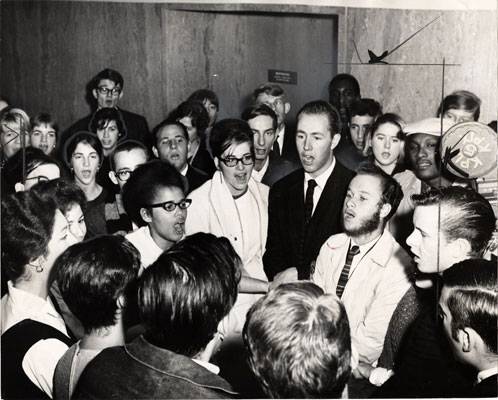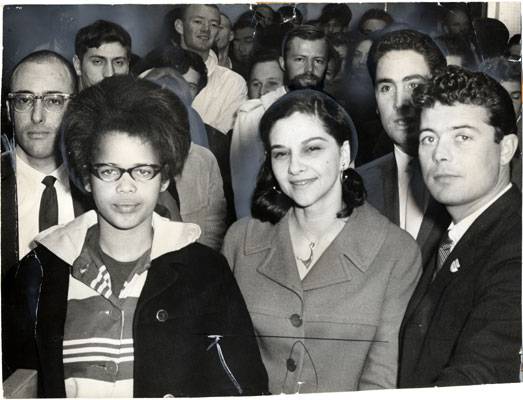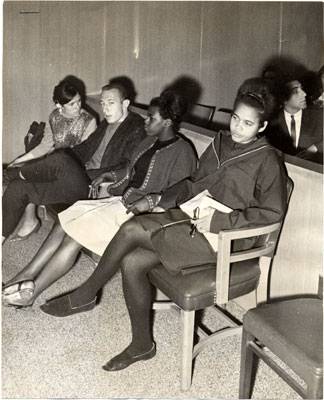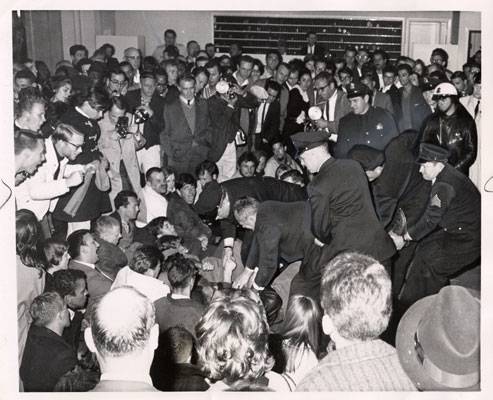Tracy Sims and the 1964 Civil Rights Protests: Difference between revisions
m Protected "Tracy Sims and the 1964 Civil Rights Protests" ([edit=sysop] (indefinite) [move=sysop] (indefinite)) |
No edit summary |
||
| Line 6: | Line 6: | ||
[[Image:Addressing-injustice.png|left]] | [[Image:Addressing-injustice.png|left]] | ||
{| style="color: black; background-color: #F5DA81;" | {| style="color: black; background-color: #F5DA81;" | ||
| Line 13: | Line 11: | ||
|} | |} | ||
It is difficult to generalize about the participants in the [[Segregation and the Civil Rights Movement in San Francisco|Civil Rights demonstrations]] that have taken place in San Francisco this past spring and during the recent Republican convention. The direct-action projects taken against the Hotel Employer’s Association, the automobile agencies, Bank of America, and the Republican platform, whether led by C.O.R.E., the NAACP, or the Ad Hoc Committee to End Discrimination, have drawn people from most colors and walks of life. | |||
However, in spite of the fact that it is difficult to generalize about the majority of the participants, the leadership and its most dedicated following hardly bear much likeness to either the ''Ebony'' or the ''Life'' magazine image of the middle class Negro or his white counterpart. Frequently, newspaper editorials describe these young men and women as “disgusting,” “beatniks,” “filthy,” and “unemployable.” And, in a way, it is true that the militant, irreverent, and unconventionally garbed character of the hard core demonstrator would make him unqualified for a position as bank teller, car salesman, or hotel clerk. And, in general, the white community, instead of looking on these people as peaceful agents of a long overdue change, look upon them almost as if they were a source of some great mythological danger. Certainly it is a fear that has been made definitely concrete in the current court handling of over five hundred cases of civil disobedience. On charges of trespassing and disturbing the peace, these participants have received up to nine month sentences, two hundred dollar fines, and stiff probation restrictions about further involvement in Civil Rights demonstrations. | |||
[[Image:Tracy Sims walking the picket line at Bank of America May 25 1964 MOR-0399.jpg|left]] | |||
'''Tracy Sims walking the picket line at Bank of America, May 25, 1964''' | |||
''Photo: San Francisco History Center, SF Public Library'' | |||
Tracy Sims, a nineteen-year-old Negro girl who is chairman of the Ad Hoc Committee, does much to create this terror, or at least strong quivery, in the white community. Though Bill Bradley of C.O.R.E. and Dr. Nathaniel Burbridge of the NAACP are strong leaders, Tracy definitely gives the movement its mystique and perhaps its most powerful tool of change. She is not only a kind of born leader, capable of sensing and commanding the attention of a large group of people, both black and white, but she seems to have an intuitive grasp of the secret weaknesses of the white power structure and its particular psyche. She comes not only armed with the necessary statistics to approach blatant cases of unfair hiring practices, she is endowed with something else; that is, she is an articulate black woman with a strong touch of the "poet as devil". And it is a touch strong enough to make the courts of San Francisco want to keep her in jail for the next two years. | |||
However, Tracy is no easy devil to describe. In appearance she is a short, hefty girl with a face that is not so beautiful as it is capable of a quick variety of moods and expressions that range from that of the innocent child, to a deep anger, to a kind of adult hymnal leftiness. On picket lines it is a face given added strength by her rough attire. She is usually dressed in leather boots, dark toreador pants, a tough suede jacket, and a silk scarf. | |||
Her manners suggest a cross between the Negro of the northern ghetto and a Negro of the southern church. That is, she seems to combine both a certain unspoiled religiosity of the south and the often defensive ways and walks of the northern ghetto. Side by side within her there is, one senses, both the southern hymn and the sounds of the local rhythm and blues station. Without self-consciously verbalizing it, she seems to express everything of what black nationalists or separatists now frequently celebrate as “soul.” And it is perhaps the lack of this particular kind of self-consciousness, combined with a large sense of "join me" generosity that enables her to attract a large number of white people. | |||
[[Image: | [[Image:C.O.R.E. sergeant Tracy Sims with crowd demonstrating outside the gates of the S.F. County Jail June 5 1964 AAK-0890.jpg|right]] | ||
'''Tracy Sims demonstrating outside gates of SF County Jail, June 5, 1964''' | |||
''Photo: San Francisco History Center, SF Public Library'' | |||
However, the popular expression “to the nitty-gritty” perhaps says the most about Tracy’s character. In a way she represents a life that is both unafraid and undeceived by the rationalizations and the often cunning appearances of the white world. In fact, she is notorious for refusing to submit to their game. Last April, when she and some friends were arrested on a somewhat dubious curfew charge, the police and the newspapers were quite sensitive to how she verbally tore into the cops who made the arrests. It is only representative of her compulsive knack to get right down to the real, or the “nitty-gritty,” and say how it really is. | |||
In turn, this background and character contribute to a special kind of picket line when led by Tracy. That is, she, or her rapidly growing group of both black and white imitators, give such a line a certain tone and rhythm. There is the offbeat clap of hands, the snaking two step, or lope step, and the often religious tone of the freedom song becomes biting and militant. And a walking that is often sheer drudgery becomes spirited, sharp and penetrating. Indeed, one thinks twice when Tracy, who has a powerful voice, leads the chorus, “God gave Noah the rainbow sign, no more water, the first next time!” | In turn, this background and character contribute to a special kind of picket line when led by Tracy. That is, she, or her rapidly growing group of both black and white imitators, give such a line a certain tone and rhythm. There is the offbeat clap of hands, the snaking two step, or lope step, and the often religious tone of the freedom song becomes biting and militant. And a walking that is often sheer drudgery becomes spirited, sharp and penetrating. Indeed, one thinks twice when Tracy, who has a powerful voice, leads the chorus, “God gave Noah the rainbow sign, no more water, the first next time!” | ||
[[Image:Cadillac dealership August 1964 AAD-4658.jpg|left | [[Image:Cadillac dealership August 1964 AAD-4658.jpg|left]] | ||
'''Cadillac dealership, August 1964''' | |||
''Photo: San Francisco History Center, SF Public Library'' | |||
The “nitty-gritty” quality of Tracy Sims and such a picket line, of course, runs deeply counter to the artifice that forms the façade of the operation of the Bank of America, the Sheraton-Palace, or the Cadillac Agency. Yet, strangely enough, it is perhaps this very quality that has succeeded in providing more job openings for Negroes in the last six months, than has twenty years of well-dressed successful black men either begging or arguing with members of the white power structure to help train and give their people jobs. Whether consciously or not, Tracy Sims seems to know a few things about how to handle those white men that her black fathers do not. | |||
On the one hand, she certainly knows that white businessmen are obviously not by nature inclined to change. Regardless of statistical arguments about the cost of supporting Negroes on unemployment and social welfare, and the cost of taking care of Negroes in prison and juvenile centers, these men are reluctant to transform their hiring practices on anything except a token level. Whatever their excuse, they are afraid to take the initiative on their own accord. If the situation were different, changes would have started taking place a hundred years ago. | On the one hand, she certainly knows that white businessmen are obviously not by nature inclined to change. Regardless of statistical arguments about the cost of supporting Negroes on unemployment and social welfare, and the cost of taking care of Negroes in prison and juvenile centers, these men are reluctant to transform their hiring practices on anything except a token level. Whatever their excuse, they are afraid to take the initiative on their own accord. If the situation were different, changes would have started taking place a hundred years ago. | ||
| Line 68: | Line 79: | ||
''Photo: San Francisco History Center, SF Public Library'' | ''Photo: San Francisco History Center, SF Public Library'' | ||
[[Image:Tracy Sims .jpg | [[Image:Tracy Sims .jpg|right]] | ||
'''Tracy Sims''' | |||
In any case, one can say that up to this point, in spite of the actions of the courts to put Tracy away almost for good, her actions have helped lead to positive and progressive changes in hiring practices, changes that might save San Francisco from the explosions that have taken place recently in Harlem and Rochester, New York. And one must also add that her kind of force can lead to a change of tone and attitude in the hiring of black people. That is, it is possible that the new Negro employee will not have to feel that he has been given a job out of the white man’s missionary pity or charity. Backed by such an outside power, that is in a way similar to a union, he can feel he has a right to a job. And instead of having a sense of self denial, he can have a sense of dignity within his job. | |||
Finally, one can only say that such has been the power of [http://www.blackpast.org/?q=aaw/sims-tracy-1945 Tracy Sims]. It is a difficult position for anyone to hold, let alone a girl who has just turned nineteen. The fact that, at the time of this writing, after having been given a week by the court to visit her mother who is sick in Texas, she has been unable to return for four weeks, perhaps suggests the burden of such a return. One can only hope that the City of San Francisco will come to its senses and begin to make changes of its own accord and allow Tracy, and give the hundred other people who have been arrested and subjected to the indulgences of the courts, return to a sane, hopefully fuller life, free of the need of even such a good devil. | Finally, one can only say that such has been the power of [http://www.blackpast.org/?q=aaw/sims-tracy-1945 Tracy Sims]. It is a difficult position for anyone to hold, let alone a girl who has just turned nineteen. The fact that, at the time of this writing, after having been given a week by the court to visit her mother who is sick in Texas, she has been unable to return for four weeks, perhaps suggests the burden of such a return. One can only hope that the City of San Francisco will come to its senses and begin to make changes of its own accord and allow Tracy, and give the hundred other people who have been arrested and subjected to the indulgences of the courts, return to a sane, hopefully fuller life, free of the need of even such a good devil. | ||
Latest revision as of 13:36, 28 June 2017
Historical Essay
Originally titled “Tracy Sims or the Necessary Devil”
By Stephen Vincent, July 1964
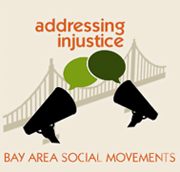
| Focusing on the young African American leader Tracy Sims active in the 1964 Civil Rights Protests, the attitude and influence of non-traditional leadership within the movement is explored. Using unorthodox methods and wasting no time to get to the heart of the matter and the base of the dominant white culture's psyche, Sims brought success to the end of racial discrimination in hiring practices. |
It is difficult to generalize about the participants in the Civil Rights demonstrations that have taken place in San Francisco this past spring and during the recent Republican convention. The direct-action projects taken against the Hotel Employer’s Association, the automobile agencies, Bank of America, and the Republican platform, whether led by C.O.R.E., the NAACP, or the Ad Hoc Committee to End Discrimination, have drawn people from most colors and walks of life.
However, in spite of the fact that it is difficult to generalize about the majority of the participants, the leadership and its most dedicated following hardly bear much likeness to either the Ebony or the Life magazine image of the middle class Negro or his white counterpart. Frequently, newspaper editorials describe these young men and women as “disgusting,” “beatniks,” “filthy,” and “unemployable.” And, in a way, it is true that the militant, irreverent, and unconventionally garbed character of the hard core demonstrator would make him unqualified for a position as bank teller, car salesman, or hotel clerk. And, in general, the white community, instead of looking on these people as peaceful agents of a long overdue change, look upon them almost as if they were a source of some great mythological danger. Certainly it is a fear that has been made definitely concrete in the current court handling of over five hundred cases of civil disobedience. On charges of trespassing and disturbing the peace, these participants have received up to nine month sentences, two hundred dollar fines, and stiff probation restrictions about further involvement in Civil Rights demonstrations.

Tracy Sims walking the picket line at Bank of America, May 25, 1964
Photo: San Francisco History Center, SF Public Library
Tracy Sims, a nineteen-year-old Negro girl who is chairman of the Ad Hoc Committee, does much to create this terror, or at least strong quivery, in the white community. Though Bill Bradley of C.O.R.E. and Dr. Nathaniel Burbridge of the NAACP are strong leaders, Tracy definitely gives the movement its mystique and perhaps its most powerful tool of change. She is not only a kind of born leader, capable of sensing and commanding the attention of a large group of people, both black and white, but she seems to have an intuitive grasp of the secret weaknesses of the white power structure and its particular psyche. She comes not only armed with the necessary statistics to approach blatant cases of unfair hiring practices, she is endowed with something else; that is, she is an articulate black woman with a strong touch of the "poet as devil". And it is a touch strong enough to make the courts of San Francisco want to keep her in jail for the next two years.
However, Tracy is no easy devil to describe. In appearance she is a short, hefty girl with a face that is not so beautiful as it is capable of a quick variety of moods and expressions that range from that of the innocent child, to a deep anger, to a kind of adult hymnal leftiness. On picket lines it is a face given added strength by her rough attire. She is usually dressed in leather boots, dark toreador pants, a tough suede jacket, and a silk scarf.
Her manners suggest a cross between the Negro of the northern ghetto and a Negro of the southern church. That is, she seems to combine both a certain unspoiled religiosity of the south and the often defensive ways and walks of the northern ghetto. Side by side within her there is, one senses, both the southern hymn and the sounds of the local rhythm and blues station. Without self-consciously verbalizing it, she seems to express everything of what black nationalists or separatists now frequently celebrate as “soul.” And it is perhaps the lack of this particular kind of self-consciousness, combined with a large sense of "join me" generosity that enables her to attract a large number of white people.

Tracy Sims demonstrating outside gates of SF County Jail, June 5, 1964
Photo: San Francisco History Center, SF Public Library
However, the popular expression “to the nitty-gritty” perhaps says the most about Tracy’s character. In a way she represents a life that is both unafraid and undeceived by the rationalizations and the often cunning appearances of the white world. In fact, she is notorious for refusing to submit to their game. Last April, when she and some friends were arrested on a somewhat dubious curfew charge, the police and the newspapers were quite sensitive to how she verbally tore into the cops who made the arrests. It is only representative of her compulsive knack to get right down to the real, or the “nitty-gritty,” and say how it really is.
In turn, this background and character contribute to a special kind of picket line when led by Tracy. That is, she, or her rapidly growing group of both black and white imitators, give such a line a certain tone and rhythm. There is the offbeat clap of hands, the snaking two step, or lope step, and the often religious tone of the freedom song becomes biting and militant. And a walking that is often sheer drudgery becomes spirited, sharp and penetrating. Indeed, one thinks twice when Tracy, who has a powerful voice, leads the chorus, “God gave Noah the rainbow sign, no more water, the first next time!”

Cadillac dealership, August 1964
Photo: San Francisco History Center, SF Public Library
The “nitty-gritty” quality of Tracy Sims and such a picket line, of course, runs deeply counter to the artifice that forms the façade of the operation of the Bank of America, the Sheraton-Palace, or the Cadillac Agency. Yet, strangely enough, it is perhaps this very quality that has succeeded in providing more job openings for Negroes in the last six months, than has twenty years of well-dressed successful black men either begging or arguing with members of the white power structure to help train and give their people jobs. Whether consciously or not, Tracy Sims seems to know a few things about how to handle those white men that her black fathers do not.
On the one hand, she certainly knows that white businessmen are obviously not by nature inclined to change. Regardless of statistical arguments about the cost of supporting Negroes on unemployment and social welfare, and the cost of taking care of Negroes in prison and juvenile centers, these men are reluctant to transform their hiring practices on anything except a token level. Whatever their excuse, they are afraid to take the initiative on their own accord. If the situation were different, changes would have started taking place a hundred years ago.
Yet, on the other hand, Tracy appears to have an intuitive awareness of the very weakness within the white establishment that can create a positive change. In her own special way, or the way of "the devil", she knows how to threaten to pull the keystone out of the arch in spite of the apparent strength of the powers that be. And it is this knowledge, or power, that has made her become the devil of the white community, and makes its public breathe with relief each time she is sentenced anew for forty-five or ninety days for trespassing or disturbing the peace.
Tracy Sims, center left, in midst of demonstration in Hall of Justice corridor, November 4, 1963.
Photo: San Francisco History Center, SF Public Library
This power, though often sensed and feared about the girl, does not often come into full play. In a way, it seems to be held back, ominous and reserved, and serves its purpose in that way by its potential instead of its use. Yet, occasionally, it reveals itself and its possible effect. Once, for example, it became terribly present right after a picket line in front of the Chrysler Automobile Agency.
Tracy had led the line for an hour and a half. It had been a spirited one, full of a variety of songs and a quick, energetic step. For the duration of the picketing, a salesman watched the action through the front window where his desk was placed. He represented the epitome of the would-be Aryan, with his direct cold blue eyes and his blond hair combed straight back. Most of the time he stood with one foot on his chair, leaned forward on his elbow, and stared. His only purpose was apparently to intimidate; however, as it happened, the intimidation was a little more than reciprocal.
Behind the salesman, at a desk farther back in the showroom, was a newly hired Negro. He was dressed, as the rest of the men were, in a neat suit; he appeared to be somewhat nervously relaxed. (The picket line had stopped all business.) On the surface, there was no “soul,” rhythm and blues, or anything “nitty-gritty” about him, just a difference of color. Tracy, however, was dressed in a black Frisco working pants and a Hickory shirt, a garb much similar to what the garbage man usually wears.
At six o’clock, when the circular line broke up, she continued the feeling and the offbeat movement of the walk. By chance she was parallel to the blond salesman behind the window. Snapping her fingers, she turned on him with a back and forward snake step and kept humming the remains of the last freedom song. The salesman, momentarily paralyzed, physically cringed and turned away, much in the way many white people do when they are first confronted with the voice of Ray Charles.
In short, it was intimidation, but not a simple kind of intimidation. It is perhaps too easy to say that Tracy plays upon or depends upon the sexual paranoia of the white man in the face of the Negro. However, it is perhaps true that she is able to return and enforce all those myths that have been invented by the white males and females about the Negro woman. She has the kind of attitude, I think, that says, “If they say we got rhythm, let’s show them we got rhythm.” What some white people have created at the expense of the loss of their own sense of rhythm, she brings or threatens to bring right back into their own being. And if these men of the white power structure still refuse to change something as cold and simply objective as a hiring practice, Tracy, as the good devil, makes them pay a crippling price. It’s either join me or fall, there are no “token” in-betweens. Such is her power, and it is this power to cripple or pull the keystone out of the arch that has made much of the white community shiver; but most importantly, it has been a very definite element in making businesses reconsider and change their employment policies.
Such intimidation as a tactic, or Tracy the devil as a tactic, is not so often debated, as secretly felt and perhaps worried about. Even people most committed to progress in Civil Rights can become queasy about her power. Her capacity to taunt, challenge and tease the very core of the problem, makes one paranoiacally wonder if, instead of positive changes, her manner of action could lead the whole structure to crumble, or to wonder whether such a crumbling might not be necessary. Certainly, from the terrifying effect of Tracy, it has become obvious that the white community is going to have to suffer a number of transformations before the possible creation of a genuinely open society. Hopefully, perhaps, the great number of white participants in these demonstrations are indicative of the coming of such a change.
Tracy Sims (wearing glasses) in court with her attorneys Malcolm Berstein (left), Beverly Axelrod, and Patrick Hallinan.
Photo: San Francisco History Center, SF Public Library
Tracy Sims in courtroom, June 1964.
Photo: San Francisco History Center, SF Public Library

Tracy Sims
In any case, one can say that up to this point, in spite of the actions of the courts to put Tracy away almost for good, her actions have helped lead to positive and progressive changes in hiring practices, changes that might save San Francisco from the explosions that have taken place recently in Harlem and Rochester, New York. And one must also add that her kind of force can lead to a change of tone and attitude in the hiring of black people. That is, it is possible that the new Negro employee will not have to feel that he has been given a job out of the white man’s missionary pity or charity. Backed by such an outside power, that is in a way similar to a union, he can feel he has a right to a job. And instead of having a sense of self denial, he can have a sense of dignity within his job.
Finally, one can only say that such has been the power of Tracy Sims. It is a difficult position for anyone to hold, let alone a girl who has just turned nineteen. The fact that, at the time of this writing, after having been given a week by the court to visit her mother who is sick in Texas, she has been unable to return for four weeks, perhaps suggests the burden of such a return. One can only hope that the City of San Francisco will come to its senses and begin to make changes of its own accord and allow Tracy, and give the hundred other people who have been arrested and subjected to the indulgences of the courts, return to a sane, hopefully fuller life, free of the need of even such a good devil.
From an unpublished Master’s Thesis “Poems and Essays: Through the Red Light” submitted to the faculty of San Francisco State College, May 1965.
Police picking out demonstrators from the lobby of the Sheraton Palace Hotel, March 7, 1964.
Photo: San Francisco History Center, San Francisco Public Library

